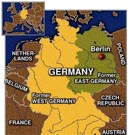Passionate German collector shows paintings in Berlin
 Berlin - For 40 years Berlin-based Reinhard Onnasch has been a committed art collector, amassing a huge array of paintings and sculptures.
Berlin - For 40 years Berlin-based Reinhard Onnasch has been a committed art collector, amassing a huge array of paintings and sculptures.
A director of art galleries in Berlin, Cologne and New York at various times in his career, Onnasch today is a friend of numerous international artists while remaining largely unknown to the broader public.
A successful German real-estate dealer and art collector, he owns more than 1,000 paintings, sculptures and sketches by European and US artists, most of which have been in storage in Cologne for the past 20 years.
Unlike dealers who make a living out of buying and selling art, Onnasch never offers the work he has acquired personally.
He did, however, lend part of his huge collection for a spell to the German Neues Museum in Westerburg in the 1990s. Then, in 2007 he created the El Sourdog Hex art foundation in Berlin, close to the Checkpoint Charlie Museum in Kreuzberg.
Since when, he has been busy promoting a series of individual exhibitions every six weeks, spotlighting the work of 19 German, US, Italian and Chilean artists.
Currently, William N Copley's paintings are on view at the Zimmerstrasse premises, close to where the Berlin Wall once cut through the city.
Onnasch first met the New York-born artist in the early 1960s on one of his stays in the United States. "He was an interesting person, someone you could talk to at length, particularly about the development of art in the 1950s," he says.
Copley's quaint canvases from the 1950s depict little men, who wear herringbone-pattern suits and derby hats on little round heads, chasing after pink-tinted, well-fed women.
Women fill his paintings in all their unembarrassed nudity," says Onnasch, who was so amused by Copley's work that he organized exhibitions for him in New York and Cologne back in the 1970s. Copley died in 1996.
Onnasch, 68, first became hooked on art at the end of the 1960s in Berlin, creating a spacious gallery on Kurfuerstendamm street and studding it with works by Miro, Ernst and Magritte and a number of other artists whose work had never been seen in Germany.
Afterwards he followed up with an exhibition at Berlin's New National Gallery titled "20 Germans - from Beuys to Richter."
Onnasch, who says he has always been drawn to artists of his own generation, owns works by German artist Markus Luepertz, visionary Chilean artist Roberto Matta, Turin-based vehicle sculptor Gianni Piacentino, land and cityscape painter Lowell Nesbitt, and American sculptor Edward Kienholz.
In March, Onnasch plans an exhibition of Luepertz's paintings at the El Sourdog Hex showrooms, followed by shows of Richard Hamilton and John Wesley's work.
In an interview with Deutsche Presse-Agentur dpa, Onnasch said he had always been impressed by artists who have made their own way in life, uninfluenced by mainstream art trends.
"During my New York time, I met a lot of American artists. In fact, I was acquainted with every one of the artists whose work I exhibit here in Berlin," he said.
In November Onnasch will wrap up his three-year El Sourdog Hex venture with an exhibition of American pop installation artist Kienholz's work.
"Kienholz, who died in 1994, was one of my biggest friends," says Onnasch. "He lived and worked here in Berlin for a spell some 20 years ago, and in fact came to the city because I was here.
"His wife and close artistic collaborator, Nancy, still visits Berlin from time to time, having an apartment here," he says.
Born in Goerlitz in eastern Germany, Onnasch spent his early post-war formative years in Kiel in northern Germany, before moving to live in the western half of divided Berlin in the late 1950s, working in the real estate business.
"In the art world my first inspiration was Rudolf Springer, a very old dealer in Berlin. In the early 1970s I did a deal with him, buying a huge cache of paintings.
"It was during a time of recession in New York and a lot of artists were suffering and the prices were very low," he said.
Currently, some 20,000 artists are to be found in Berlin, seeking to make a living from their art. "It's difficult for some of them, but a lot happens here art-wise and they come because of the rents: the cheaper studios and accommodation.
"Now we are free of the problems we endured during the Cold War, years things have changed and Berlin once again is the central place for Germany," says Onnasch. (dpa)